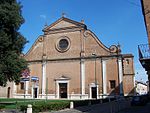Palazzo Pendaglia
Gothic architecture in Emilia-RomagnaHouses completed in the 15th centuryPalaces in Ferrara

The Palazzo Pendaglia is a 15th-century, Gothic-style palace located at Via Sogari #3, in Ferrara, Italy. In 2015, it houses an institute for training restaurant and hotel staff (Istituto Alberghiero "Orio Vergani"). Commissioned by the aristocratic Pendaglia family, in the 18th century it became property of the commune. During the Napoleonic era, it served as barracks, but has served as dormitory, nursing home, and school. The building has suffered from fires and demolitions, but still maintains some 15th-century frescoes and decoration. The sober brick facade has an ogival portal.
Excerpt from the Wikipedia article Palazzo Pendaglia (License: CC BY-SA 3.0, Authors, Images).Palazzo Pendaglia
Via Sogari, Ferrara Giardino
Geographical coordinates (GPS) Address Nearby Places Show on map
Geographical coordinates (GPS)
| Latitude | Longitude |
|---|---|
| N 44.8357 ° | E 11.6232 ° |
Address
Istituto Professionale di Stato per i Servizi Alberghieri e per la Ristorazione "Orio Vergani"
Via Sogari
44121 Ferrara, Giardino
Emilia-Romagna, Italy
Open on Google Maps










